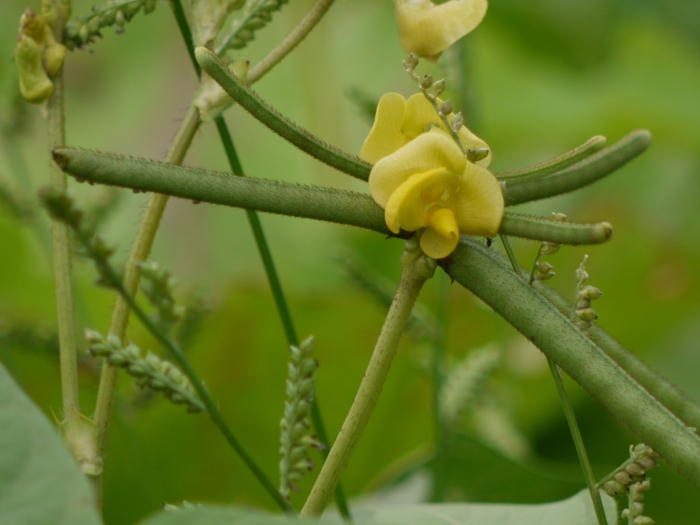Mung Bean
(Vigna radiata)
Mung Bean (Vigna radiata)
/
/

© Dinesh Valke
CC BY-SA 4.0
Image By:
© Dinesh Valke
Recorded By:
Copyright:
CC BY-SA 4.0
Copyright Notice:
Photo by: © Dinesh Valke | License Type: CC BY-SA 4.0 | License URL: http://creativecommons.org/licenses/by-sa/4.0/ | Uploader: dineshvalke | Publisher: iNaturalist |

























Estimated Native Range
Summary
Vigna radiata, commonly known as mung bean or green gram, is an annual herbaceous legume native to open and sunny habitats in India. It has been cultivated throughout East, Southeast, and South Asia for its edible seeds and sprouts. Mung bean thrives in warm, tropical climates and prefers well-drained, fertile soils. It is capable of fixing atmospheric nitrogen, which enhances soil fertility. The plant typically reaches a height of 15-125 cm (6-49 inches) and features hairy, vertical stems. It produces small, yellow flowers and hairy, cylindrical pods that are 4-6 inches long containing 10-15 seeds each. The seeds are small, round, and green, and they are highly nutritious, offering a rich source of protein and dietary fiber.
Mung bean is valued for its rapid growth and adaptability to a range of soil types, although it performs best in loamy soils with neutral pH. It requires regular watering, especially during flowering and pod development, but is relatively drought-tolerant once established. In cultivation, mung beans are often grown for their sprouts, which are a staple in Asian cuisine, both in savory and sweet dishes. The plant is also used as a cover crop or green manure due to its nitrogen-fixing ability. While generally pest-resistant, mung beans can be susceptible to bean fly, powdery mildew, and root rot in poor drainage conditions. It is not typically grown ornamentally but is highly regarded for its nutritional and culinary uses.CC BY-SA 4.0
Mung bean is valued for its rapid growth and adaptability to a range of soil types, although it performs best in loamy soils with neutral pH. It requires regular watering, especially during flowering and pod development, but is relatively drought-tolerant once established. In cultivation, mung beans are often grown for their sprouts, which are a staple in Asian cuisine, both in savory and sweet dishes. The plant is also used as a cover crop or green manure due to its nitrogen-fixing ability. While generally pest-resistant, mung beans can be susceptible to bean fly, powdery mildew, and root rot in poor drainage conditions. It is not typically grown ornamentally but is highly regarded for its nutritional and culinary uses.CC BY-SA 4.0
Plant Description
- Plant Type: Herb
- Height: 2-3.9 feet
- Width: 1-2 feet
- Growth Rate: Rapid
- Flower Color: Yellow
- Flowering Season: Summer
- Leaf Retention:
Growth Requirements
- Sun: Full Sun, Part Shade
- Water: Medium
- Drainage: Medium, Slow
Common Uses
Edible*Disclaimer: Easyscape's listed plant edibility is for informational use. Always verify the safety and proper identification of any plant before consumption., Low Maintenance
Natural Habitat
Open and sunny habitats in India
Other Names
Common Names: Golden Gram, Green Gram, Celera-Bean, Mungo-Bean, 녹두, Green Gam
Scientific Names: , Vigna radiata, ? dublobata, Azukia radiata, Phaseolus aureus, Phaseolus radiatus, Phaseolus radiatus var. aureus, Phaseolus radiatus var. grandis, Phaseolus radiatus var. typicus, Vigna opistricha
GBIF Accepted Name: